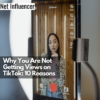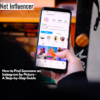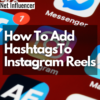Agency
The Influence Agency: 360° Approach Delivers Seamless Campaign Integration
The Influence Agency emerged in 2017 as a small Toronto-based startup focused on influencer marketing just as brands were realizing that social media creators could drive results traditional advertising couldn’t provide. Eight years later, the agency serves clients like NBC Universal, Puma, and Jamieson Vitamins with a suite of digital services extending beyond influencer partnerships.
“The best marketing campaigns are a lot more holistic than just influencers,” says Tanya Cruz, Director of Communications at The Influence Agency. “We want to make sure that we understand the full mechanics of how the best campaigns work.”
This integrated approach responds to a shortfall in the market: brands struggling to connect their creator partnerships with broader marketing efforts. While many agencies specialize in either traditional or digital channels, The Influence Agency built its model specifically for companies seeking cohesion across all consumer touchpoints—from influencer content to website experience to retail presence.
While working at a boutique agency focused on brands and talent, Tanya observed two simultaneous trends changing the industry: “Every year, almost like clockwork, especially during the holidays at the end of the year, we would hear about how certain news organizations are shrinking, our media contacts were leaving, or they’re moving to freelance,” she explains.
Meanwhile, what were once called “bloggers” were transforming into “influencers,” commanding growing attention from brands. This dual observation catalyzed Tanya’s move from traditional marketing to digital, eventually leading her to The Influence Agency.
Services That Work in Concert
When Tanya joined the agency as a content coordinator, it was “just a little small startup company with a big vision” primarily focused on influencer marketing. The agency quickly recognized the need to expand.
“Since then, we have developed a social media and creative departments. We have account managers who lead the influencer marketing campaigns. We have paid social departments and CRO. It’s like a full suite of marketing services,” Tanya explains.
She continues, “Our service portfolio is strategically segmented to align with our clients’ overarching objectives—spanning the full spectrum of digital marketing, from upper-funnel brand awareness initiatives to lower-funnel e-commerce conversion drivers and all performance-focused stages in between.”
What makes this approach distinctive is how these services are coordinated to create seamless customer experiences because “that’s where the biggest impact we think could be had,” Tanya says.
Case Studies: Integration in Action
The Influence Agency’s approach is best illustrated through their client work. Their campaign for Staples Canada’s back-to-school season demonstrates how creator relationships transcend traditional social media posts.
“We partnered with a lot of amazing influencers that basically represented their different target demographics, like a teacher, student, parent, and a tech person,” Tanya explains. Rather than limiting these creators to social content, “they used these influencers to do basically a photo shoot, and they used their photos in all the retail outlets during the campaign.”
This strategy created multiple content opportunities as creators shared behind-the-scenes footage, their participation in the campaign, and their reactions to seeing themselves featured in stores.
“It was a really nice integrated campaign and I think was a really good example of how you can really extend the relationship with creators beyond just social media,” Tanya reflects.
Another example is their BarBurrito campaign, which showcased their multi-service capabilities. “We did a really big BarBurrito campaign that was very multi-service with a commercial and some basketball ambassadors from our local team at the Toronto Raptors. And that was really cool because we did a lot of the branding that was being circulated during prime time spots during Raptors games.”
A Balanced Approach to ROI
For many brands, proving ROI remains a key challenge in influencer marketing. The Influence Agency addresses this through a combination of client education and practical measurement.
“I think first and foremost what we think is super important is client education,” Tanya emphasizes. “People come to us thinking that if we’re gonna invest in this, it’s gonna mean all this. But we need to understand that every service has a different purpose in the marketing funnel.”
Tanya points out that many digital marketing services, particularly influencer partnerships, are primarily brand awareness plays rather than direct conversion tools. However, The Influence Agency uses specific tracking methods to measure impact:
“There’s a lot of either code that they can use, such as UTM links, so we can track and understand where the traffic is coming from and where the conversions are coming from,” Tanya explains. For connected TV campaigns, they’ve used QR codes to track clicks to the site, giving clients concrete metrics.
Tanya offers her own perspective on the ROI debate, noting the historical context of traditional media: “It’s actually very funny when a lot of brands are trying to prove the ROI of Influencer, when historically there wasn’t a lot of ways to fully prove ROI on traditional [media].”
She points out that even today, traditional media metrics are often estimates rather than precise measurements.
The Relevance of Traditional Media
Despite their digital focus, The Influence Agency maintains that traditional media still has an important role to play in strategies. “Traditional media still provides a validation point for companies and brands that’s still meaningful. And I don’t think it’s going to go away,” Tanya asserts.
This perspective differentiates them from agencies that have abandoned traditional channels entirely. Tanya sees value in both domains: “The conversation is how are you going to incorporate both? They both have their pros and they are big drivers of what make great campaign successful. So I wouldn’t ignore one or the other.”
This balanced view stems partly from Tanya’s background in journalism and PR, giving The Influence Agency an advantage when developing campaigns that leverage multiple channels.
Private Communities and Changing Creator Roles
Looking forward, Tanya identifies two trends that will shape creator economy strategies.
First, she sees creators moving beyond content production: “The way that we’ll use influencers will continue to [change]. So I think we’re going to be using influencers in more unique ways, like exclusive products, in commercials, in connected TV, in real-world spaces, than just creating content online.”
Second, she highlights the growing importance of owned communities: “What we’ve seen in the last couple years in particular is that social media is a very volatile place. We do not have control of the platforms or the algorithms. But what we do know time and time again is the importance of owning your audience.”
Tanya points to platforms like Discord and Substack as evidence of this shift: “We’re seeing communities like Discord grow an insane amount in the last year. We’re seeing Substack to the email marketing platform also grow a lot.”
According to her, this trend toward private, owned communities aligns with The Influence Agency’s integrated approach.
Culture as the Foundation for Progress
In addition to their strategic approach, The Influence Agency attributes much of their success to their internal culture.
“When you look at our Glassdoor reviews, when you look at our retention rate, it’s really high for an agency,” Tanya notes. “Especially in an industry where turnover can be very high, there can be a lot of negative stereotypes about working in an agency.”
Their success in this area, Tanya continues, stems from their commitment to individual development: “We have cultivated a space where we’re committed to the growth of not just the agency but also the individuals. We’re very collaborative, we encourage really big ideas across the team.”
This culture of collaboration also applies to how Tanya approaches mentorship, having guided dozens of women, students, recent graduates, and newcomers throughout her career. The emphasis on knowledge-sharing and support reflects the agency’s broader values.
The Integration Imperative
Tanya offers a clear prediction for brands in the creator economy: “The brands that will continue to win will have integration as a priority in everything that they do, regardless of the services that they’re working on.”
This integration-first mindset represents The Influence Agency’s core value proposition. “I think the soul of it is always going to be community. And I think that the brands that fail will continue to work in a very siloed approach to everything,” Tanya predicts.
The agency is focusing on how artificial intelligence can enhance their work: “We’re always big on being big adopters. Obviously, we’re working with AI a lot more, understanding how to work more efficiently within the space to unleash more creativity more than anything.”
Their ultimate goal remains finding alignment with clients who share their vision: “The big goal is to keep growing and continue to work with clients and partners who are open to thinking creatively and out of the box like our team does. Because when those energies align, I think a lot of magic happens.”





















